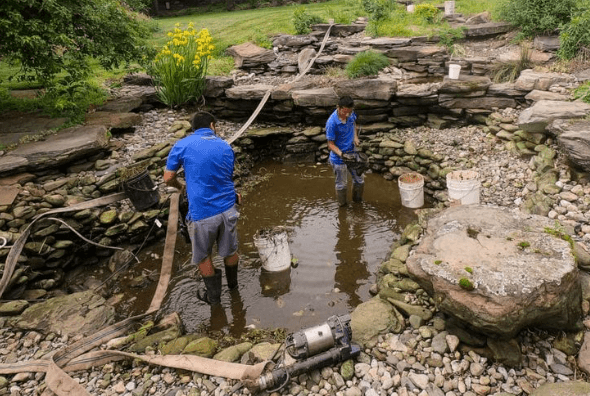A Cleaner Pond Starts with Simple, Consistent Care

Ponds are peaceful features that bring beauty and biodiversity to any garden. Whether you’ve built a pond to attract frogs and dragonflies or simply enjoy the calming sound of water, keeping it clean ensures your space remains inviting for both people and wildlife. A cleaner pond doesn’t mean it has to be sterile—it’s about maintaining a healthy balance between nature and care.
By using thoughtful, low-impact methods, you can enjoy a cleaner pond all year without disturbing the ecosystem. From skimming debris to managing algae, here’s how to maintain a natural pond that supports life and stays visually appealing.
Surface Skimming: The First Step to Clarity
The surface of your pond collects leaves, pollen, and small floating debris almost daily. These elements, if left alone, sink and feed algae growth. One of the easiest and most effective habits for a cleaner pond is regular skimming.
Using a soft mesh net, gently remove debris once or twice a week. Focus especially on the fall season when leaves drop heavily. However, avoid over-skimming—some plant material is beneficial for small creatures like frogs and aquatic insects. Let nature do its part, while you manage the excess.
Preventing Algae Before It Spreads
Algae can transform a lovely pond into a green, slimy mess. While it’s a natural part of any aquatic environment, too much algae causes oxygen levels to plummet, making it harder for fish and plants to survive.
To support a cleaner pond, introduce floating plants such as duckweed or water lilies. These reduce sunlight exposure, limiting algae growth naturally. Avoid feeding fish too often—leftover food fuels algae growth. If algae gets out of hand, use treatments that are safe for wildlife and follow dosage instructions carefully.
Trimming Plants to Keep Balance
Aquatic plants help filter water and provide shade and shelter. But they can quickly take over if not managed. For a cleaner pond, regularly trim back fast-growing species such as cattails or reeds.
Focus on the outer edges, where plant growth is most visible and likely to spread into walkways or lawn space. Leave trimmed plants by the water for a day to allow insects and small animals to return before composting the cuttings.
Avoid Draining—Refresh Instead
When a pond starts looking murky, some may think draining it completely is the answer. In reality, this strips away beneficial bacteria and causes sudden changes that can harm wildlife.
Instead, aim for partial water changes—replace about 10–20% of the water every few weeks. Use rainwater or allow tap water to sit for 24 hours to eliminate chlorine. This approach refreshes your pond without creating shock for plants and animals.
Tackling Sludge with Care
Over time, organic material like dead leaves, waste, and algae settles on the bottom, forming sludge. While a little is harmless, too much can release foul odors and cloud the water.
To achieve a cleaner pond, use a pond vacuum or long-handled net to remove excess sludge in early spring or fall. Avoid cleaning in late spring when frogs and insects might be nesting in the muck. Always disturb the pond bed gently and only where needed.
Monitor Wildlife for Clues
Wildlife activity offers insight into your pond’s health. A busy pond full of frogs, birds, and insects usually signals good water quality and balance. If your pond suddenly becomes quiet, it may need attention.
Look for signs like dying plants, surface scum, or cloudy water. Address these by adding native aquatic plants, reducing disturbance, and limiting any chemical use. A cleaner pond will often encourage wildlife to return naturally.
Adjust Your Care with the Seasons
Each season presents new challenges and opportunities for pond care:
- Spring: Clean out excess debris, refresh part of the water, and check on new plant growth.
- Summer: Monitor algae, trim plants, and top up water levels during dry spells.
- Fall: Skim fallen leaves and prepare the pond for colder weather by reducing plant mass.
- Winter: Stop feeding fish once temperatures drop, and ensure gas exchange by keeping a section of the surface ice-free.
By syncing your efforts with the seasons, your pond will stay cleaner and more balanced year-round.
Let Nature Do Some of the Work
A cleaner pond doesn’t require constant intervention. In fact, letting nature lend a hand often makes the job easier. Frogs help control insects, native plants stabilize water conditions, and oxygenating plants keep the pond healthier overall.
Avoid excessive use of filters or additives unless truly needed. By choosing a natural, low-intervention approach, your pond stays cleaner with less work and less disruption to its ecosystem.
Clearing Up Confusion
How can I keep a cleaner pond without harming wildlife?
Focus on natural methods—regular skimming, gentle plant pruning, partial water changes, and adding shade with floating plants. Avoid harsh chemicals and support native wildlife.
How often should I remove sludge?
Sludge can be removed once or twice a year, ideally in early spring and fall. Avoid deep cleaning during peak breeding seasons for frogs or insects.
Is it bad to have some algae in the pond?
A small amount of algae is natural and expected. It only becomes a problem when it grows excessively, blocking light and reducing oxygen. Managing sunlight and nutrients is the best prevention.
What type of plants are best for a cleaner pond?
Choose a mix of floating plants (like water lilies), submerged oxygenators (like hornwort), and marginal plants (like pickerelweed) to keep the water clean and support wildlife.
Can I swim in a pond if it looks clean?
If the pond is maintained naturally, the water is clear, and harmful bacteria are not present, swimming is generally safe. Still, always test the water if in doubt and avoid swimming during treatment applications.
